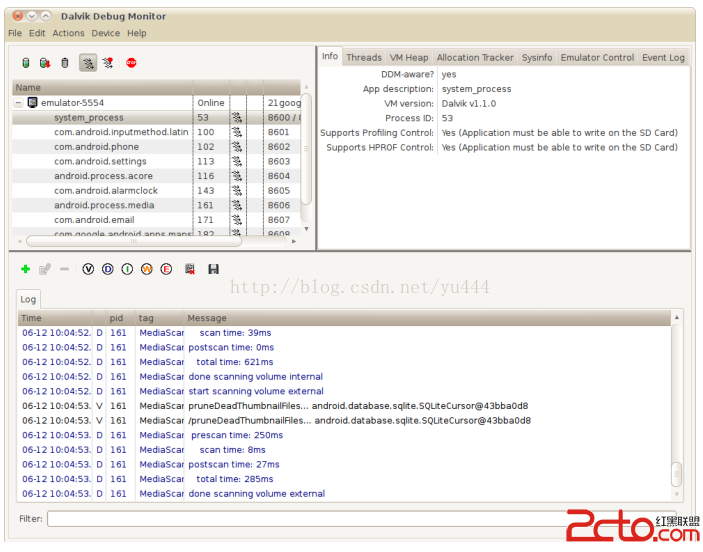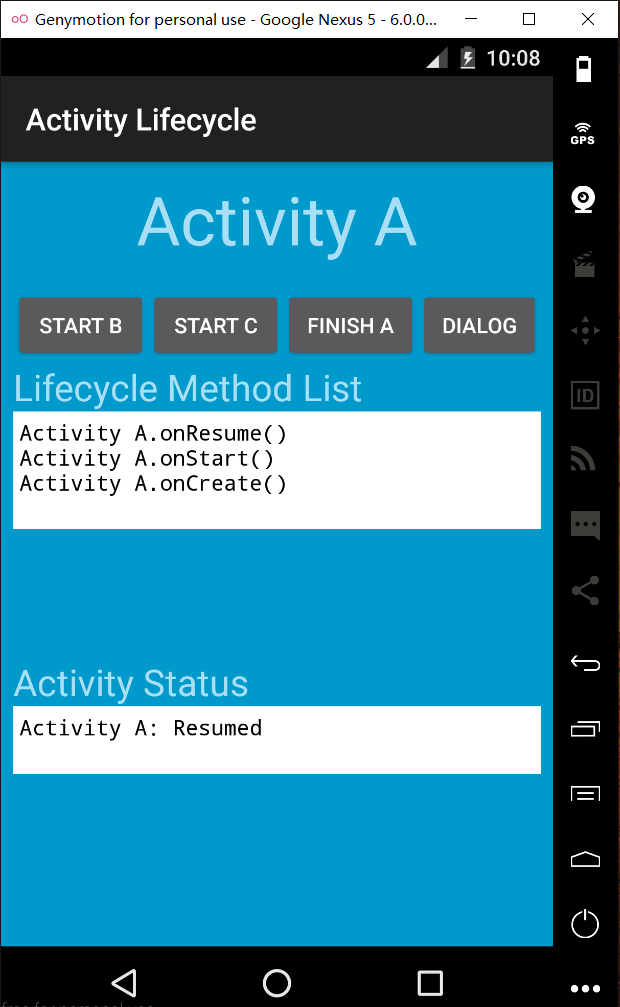編輯:關於Android編程
public class Scroller {
private int mMode;
private int mStartX;
private int mStartY;
private int mFinalX;
private int mFinalY;
private int mMinX;
private int mMaxX;
private int mMinY;
private int mMaxY;
......
/**
* Call this when you want to know the new location. If it returns true,
* the animation is not yet finished.
*/
public boolean computeScrollOffset() {
if (mFinished) {
return false;
}
int timePassed = (int)(AnimationUtils.currentAnimationTimeMillis() - mStartTime);
if (timePassed < mDuration) {
switch (mMode) {
case SCROLL_MODE:
float x = timePassed * mDurationReciprocal;
if (mInterpolator == null)
x = viscousFluid(x);
else
x = mInterpolator.getInterpolation(x);
mCurrX = mStartX + Math.round(x * mDeltaX);
mCurrY = mStartY + Math.round(x * mDeltaY);
break;
case FLING_MODE:
final float t = (float) timePassed / mDuration;
final int index = (int) (NB_SAMPLES * t);
float distanceCoef = 1.f;
float velocityCoef = 0.f;
if (index < NB_SAMPLES) {
final float t_inf = (float) index / NB_SAMPLES;
final float t_sup = (float) (index + 1) / NB_SAMPLES;
final float d_inf = SPLINE_POSITION[index];
final float d_sup = SPLINE_POSITION[index + 1];
velocityCoef = (d_sup - d_inf) / (t_sup - t_inf);
distanceCoef = d_inf + (t - t_inf) * velocityCoef;
}
mCurrVelocity = velocityCoef * mDistance / mDuration * 1000.0f;
mCurrX = mStartX + Math.round(distanceCoef * (mFinalX - mStartX));
// Pin to mMinX <= mCurrX <= mMaxX
mCurrX = Math.min(mCurrX, mMaxX);
mCurrX = Math.max(mCurrX, mMinX);
mCurrY = mStartY + Math.round(distanceCoef * (mFinalY - mStartY));
// Pin to mMinY <= mCurrY <= mMaxY
mCurrY = Math.min(mCurrY, mMaxY);
mCurrY = Math.max(mCurrY, mMinY);
if (mCurrX == mFinalX && mCurrY == mFinalY) {
mFinished = true;
}
break;
}
}
else {
mCurrX = mFinalX;
mCurrY = mFinalY;
mFinished = true;
}
return true;
}
public void startScroll(int startX, int startY, int dx, int dy, int duration) {
mMode = SCROLL_MODE;
mFinished = false;
mDuration = duration;
mStartTime = AnimationUtils.currentAnimationTimeMillis();
mStartX = startX;
mStartY = startY;
mFinalX = startX + dx;
mFinalY = startY + dy;
mDeltaX = dx;
mDeltaY = dy;
mDurationReciprocal = 1.0f / (float) mDuration;
}
/**
* Start scrolling based on a fling gesture. The distance travelled will
* depend on the initial velocity of the fling.
*
* @param startX Starting point of the scroll (X)
* @param startY Starting point of the scroll (Y)
* @param velocityX Initial velocity of the fling (X) measured in pixels per
* second.
* @param velocityY Initial velocity of the fling (Y) measured in pixels per
* second
* @param minX Minimum X value. The scroller will not scroll past this
* point.
* @param maxX Maximum X value. The scroller will not scroll past this
* point.
* @param minY Minimum Y value. The scroller will not scroll past this
* point.
* @param maxY Maximum Y value. The scroller will not scroll past this
* point.
*/
public void fling(int startX, int startY, int velocityX, int velocityY,
int minX, int maxX, int minY, int maxY) {
// Continue a scroll or fling in progress
if (mFlywheel && !mFinished) {
float oldVel = getCurrVelocity();
float dx = (float) (mFinalX - mStartX);
float dy = (float) (mFinalY - mStartY);
float hyp = FloatMath.sqrt(dx * dx + dy * dy);
float ndx = dx / hyp;
float ndy = dy / hyp;
float oldVelocityX = ndx * oldVel;
float oldVelocityY = ndy * oldVel;
if (Math.signum(velocityX) == Math.signum(oldVelocityX) &&
Math.signum(velocityY) == Math.signum(oldVelocityY)) {
velocityX += oldVelocityX;
velocityY += oldVelocityY;
}
}
mMode = FLING_MODE;
mFinished = false;
float velocity = FloatMath.sqrt(velocityX * velocityX + velocityY * velocityY);
mVelocity = velocity;
mDuration = getSplineFlingDuration(velocity);
mStartTime = AnimationUtils.currentAnimationTimeMillis();
mStartX = startX;
mStartY = startY;
float coeffX = velocity == 0 ? 1.0f : velocityX / velocity;
float coeffY = velocity == 0 ? 1.0f : velocityY / velocity;
double totalDistance = getSplineFlingDistance(velocity);
mDistance = (int) (totalDistance * Math.signum(velocity));
mMinX = minX;
mMaxX = maxX;
mMinY = minY;
mMaxY = maxY;
mFinalX = startX + (int) Math.round(totalDistance * coeffX);
// Pin to mMinX <= mFinalX <= mMaxX
mFinalX = Math.min(mFinalX, mMaxX);
mFinalX = Math.max(mFinalX, mMinX);
mFinalY = startY + (int) Math.round(totalDistance * coeffY);
// Pin to mMinY <= mFinalY <= mMaxY
mFinalY = Math.min(mFinalY, mMaxY);
mFinalY = Math.max(mFinalY, mMinY);
}
/**
* Stops the animation. Contrary to {@link #forceFinished(boolean)},
* aborting the animating cause the scroller to move to the final x and y
* position
*
* @see #forceFinished(boolean)
*/
public void abortAnimation() {
mCurrX = mFinalX;
mCurrY = mFinalY;
mFinished = true;
}
....上面我貼出來的類方法都是常用的幾個方法,這裡我來分別解釋每個方法的作用和用法,首先我們還是來看computeScrollOffset()這個方法吧,我們看到它的注釋 /***google官方的注釋還是挺給力的,我就不多說什麼了,接著來看下一個方法。startScroll()這個方法又該什麼時候用呢?又該在哪個地方用呢?其實我們需要做一個滑動效果,我們就需要調用這個方法幫助我們時時的計算我們當前的位置。這樣我們就不用自己去計算當前的速度是多少當前該走到哪裡了。這裡官方也給出了一個例子我們還是來看看到底是怎麼用的?To track the changing positions of the x/y coordinates, use * {@link #computeScrollOffset}. The method returns a boolean to indicate * whether the scroller is finished. If it isn't, it means that a fling or * programmatic pan operation is still in progress. You can use this method to * find the current offsets of the x and y coordinates, for example:
* *if (mScroller.computeScrollOffset()) { * // Get current x and y positions * int currX = mScroller.getCurrX(); * int currY = mScroller.getCurrY(); * ... * }
private Scroller mScroller = new Scroller(context);
* ...
* public void zoomIn() {
* // Revert any animation currently in progress
* mScroller.forceFinished(true);
* // Start scrolling by providing a starting point and
* // the distance to travel
* mScroller.startScroll(0, 0, 100, 0);
* // Invalidate to request a redraw
* invalidate();
* } Android AlarmManager鬧鐘實現
Android AlarmManager鬧鐘實現
什麼是AlarmManager? AlarmManager是Android中常用的一種系統級別的提示服務,在特定的時刻為我們廣播一個指定的Intent。簡單
 Android官方開發文檔Training系列課程中文版:通知用戶之大視圖通知
Android官方開發文檔Training系列課程中文版:通知用戶之大視圖通知
原文地址:http://android.xsoftlab.net/training/notify-user/expanded.html通知在通知欄中以兩種風格呈現:正常視
 Android Development Notes-2
Android Development Notes-2
Summary:SDK, ADB, Active, Intents and Tasks-The Android SDK is made of mostly off-the
 關於Google 教程中 Manage the Activity Lifecycle 示例的學習
關於Google 教程中 Manage the Activity Lifecycle 示例的學習
昨天晚上我看了Google training裡面Manage the Activity Lifecycle這一節,看了以後學到很多以前看書,看視頻都沒有了解過的東西,Go